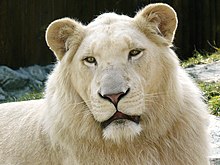


Leucism (/ˈluːsɪzəm, -kɪz-/)[2][3][4] is a wide variety of conditions that result in partial loss of pigmentation in an animal—causing white, pale, or patchy coloration of the skin, hair, feathers, scales, or cuticles, but not the eyes.[4] It is occasionally spelled leukism. Some genetic conditions that result in a "leucistic" appearance include piebaldism, Waardenburg syndrome, vitiligo, Chédiak–Higashi syndrome, flavism, isabellinism, xanthochromism, axanthism, amelanism, and melanophilin mutations. Pale patches of skin, feathers, or fur (often referred to as "depigmentation") can also result from injury.[5]
- ^ Cho, Yun Sung; Hu, Li; Hou, Haolong; Lee, Hang; Xu, Jiaohui; Kwon, Soowhan; Oh, Sukhun; Kim, Hak-Min; Jho, Sungwoong; Kim, Sangsoo; Shin, Young-Ah (2013-09-17). "The tiger genome and comparative analysis with lion and snow leopard genomes". Nature Communications. 4 (1): 2433. Bibcode:2013NatCo...4.2433C. doi:10.1038/ncomms3433. ISSN 2041-1723. PMC 3778509. PMID 24045858.
- ^ "leucistic". Oxford Dictionaries. Oxford University Press. Archived from the original on August 10, 2012. Retrieved January 9, 2016.
- ^ Merriam-Webster, Merriam-Webster's Unabridged Dictionary, Merriam-Webster, archived from the original on 2020-05-25, retrieved 2015-11-12.
- ^ a b "leucism". The American Heritage Dictionary of the English Language (5th ed.). HarperCollins.
- ^ "Depigmentation of Skin: Symptoms, Signs, Causes & Treatment". MedicineNet. Retrieved 2020-06-23.